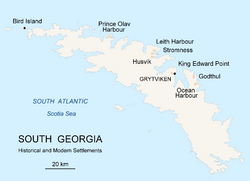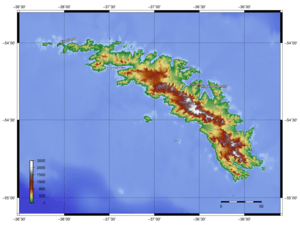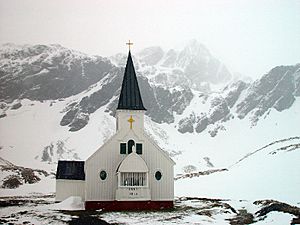South Georgia (island) facts for kids

South Georgia
|
|

Map of South Georgia Island
|
|
| Geography | |
|---|---|
| Location | South Atlantic |
| Coordinates | 54°24′S 36°42′W / 54.4°S 36.7°W |
| Archipelago | South Georgia group |
| Area | 3,528 km2 (1,362 sq mi) |
| Length | 167.4 km (104.02 mi) |
| Width | 37 km (23 mi) |
| Highest elevation | 2,934 m (9,626 ft) |
| Highest point | Mount Paget |
| Largest settlement | King Edward Point |
| Demographics | |
| Population | 32 (summer) 16 (winter) |
South Georgia (Spanish: Isla San Pedro) is an island in the southern Atlantic Ocean that is part of the British Overseas Territory of South Georgia and the South Sandwich Islands. The main settlement is Grytviken. South Georgia is 167.4 kilometres (104 mi) long and 1.4 to 37 km (0.9 to 23.0 miles) wide. It is about 830 km (520 mi) northeast of Coronation Island and 550 km (340 mi) northwest from Zavodovski Island, the nearest South Sandwich island.
History
The island of South Georgia was probably discovered in 1675 by Anthony de la Roché, a London merchant, and was named Roche Island on a number of early maps. It was sighted by a commercial Spanish ship named León operating out of Saint-Malo on 28 June or 29 June 1756. According to Argentine historians, it was explored on 29 June 1756, St Peter's Day, hence its Spanish name Isla San Pedro, literally "St Peter's Island".
The mariner Captain James Cook in HMS Resolution accompanied by HMS Adventure made the first landing, survey and mapping of South Georgia. As mandated by the Admiralty, on 17 January 1775 he took possession for Britain and renamed the island 'Isle of Georgia' for King George III.
Commercial sealing was conducted on the island between 1786 and 1913. During that period 131 sealing visits are recorded, eight of which ended when the vessel was wrecked. Modern industrial sealing associated with whaling stations was carried out between 1909 and 1964. Sealing era relics include iron try pots, hut ruins, graves and inscriptions.
Argentine occupation
On 19 March 1982, a group of Argentinians arrived at Leith Harbour and raised the Argentine flag on the island. On 3 April, the second day of the Falklands War, Argentine naval forces occupied the island. South Georgia was retaken by British forces on 25 April during Operation Paraquet.
Geography and fauna
The island is classified as an ET or polar tundra climate on the Köppen-Geiger classification system. It has no tree cover, and there is generally snow on the island during the winter months (April–November). The terrain is mountainous, with a central ridge and many fjords and bays along the coast. Additionally, South Georgia is a breeding ground for elephant seals, fur seals, and king penguins. The island is home to the South Georgia Pintail and the South Georgia Pipit, the only known habitat for these birds.
There are 25 native vascular plants on South Georgia, and 76 non-native species have been recorded.
The island's topography includes a stepped sequence of flat surfaces interpreted as wave-cut platforms formed when sea level was higher relative to the island. At sea level strandflats have been described.
In 2013, teams of Norwegian government shooters and Sami reindeer herders culled all 3,500 reindeer on the island. The animals had been introduced by Norwegian whalers in the early 20th century for food and sport hunting, but were later seen as a pest, damaging the island's flora and wider ecosystem. Karl Erik Kilander, the project manager, said the culled reindeer were frozen and taken to the Falkland Islands where they were sold to local residents and cruise ship operators.
In 2018, after a multiyear extermination effort, the island was declared free of invasive rodents and the number of South Georgia Pipits had clearly increased.
The island lies in the path of large icebergs drifting northward from Antarctica. Iceberg A-38 grounded off the island in 2004, resulting in indirect but severe effects on local wildlife by disturbing life on the seafloor and blocking foraging routes of seals and penguins. In 2020, the colossal 4,200 square kilometres (1,600 sq mi) Iceberg A-68, similar in size to the island itself, was initially believed to be on a similar collision course but broke apart before collision with the island.
See also
 In Spanish: Isla San Pedro (Georgia del Sur) para niños
In Spanish: Isla San Pedro (Georgia del Sur) para niños



